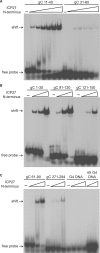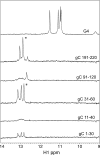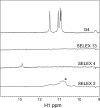The HSV-1 ICP27 RGG box specifically binds flexible, GC-rich sequences but not G-quartet structures
- PMID: 19783816
- PMCID: PMC2790906
- DOI: 10.1093/nar/gkp793
The HSV-1 ICP27 RGG box specifically binds flexible, GC-rich sequences but not G-quartet structures
Abstract
Herpes simplex virus 1 (HSV-1) protein ICP27, an important regulator for viral gene expression, directly recognizes and exports viral RNA through an N-terminal RGG box RNA binding motif, which is necessary and sufficient for RNA binding. An ICP27 N-terminal peptide, including the RGG box RNA binding motif, was expressed and its binding specificity was analyzed using EMSA and SELEX. DNA oligonucleotides corresponding to HSV-1 glycoprotein C (gC) mRNA, identified in a yeast three-hybrid analysis, were screened for binding to the ICP27 N-terminal peptide in EMSA experiments. The ICP27 N-terminus was able to bind most gC substrates. Notably, the ICP27 RGG box was unable to bind G-quartet structures recognized by the RGG domains of other proteins. SELEX analysis identified GC-rich RNA sequences as a common feature of recognition. NMR analysis of SELEX and gC sequences revealed that sequences able to bind to ICP27 did not form secondary structures and conversely, sequences that were not able to bind to ICP27 gave spectra consistent with base-pairing. Therefore, the ICP27 RGG box is unique in its recognition of nucleic acid sequences compared to other RGG box proteins; it prefers flexible, GC-rich substrates that do not form stable secondary structures.
Figures








Similar articles
-
Three arginine residues within the RGG box are crucial for ICP27 binding to herpes simplex virus 1 GC-rich sequences and for efficient viral RNA export.J Virol. 2010 Jul;84(13):6367-76. doi: 10.1128/JVI.00509-10. Epub 2010 Apr 21. J Virol. 2010. PMID: 20410270 Free PMC article.
-
Mapping of functional regions in the amino-terminal portion of the herpes simplex virus ICP27 regulatory protein: importance of the leucine-rich nuclear export signal and RGG Box RNA-binding domain.J Virol. 2002 Dec;76(23):11866-79. doi: 10.1128/jvi.76.23.11866-11879.2002. J Virol. 2002. PMID: 12414929 Free PMC article.
-
The RGG box motif of the herpes simplex virus ICP27 protein mediates an RNA-binding activity and determines in vivo methylation.J Virol. 1996 Nov;70(11):7445-53. doi: 10.1128/JVI.70.11.7445-7453.1996. J Virol. 1996. PMID: 8892862 Free PMC article.
-
The many roles of the highly interactive HSV protein ICP27, a key regulator of infection.Future Microbiol. 2011 Nov;6(11):1261-77. doi: 10.2217/fmb.11.119. Future Microbiol. 2011. PMID: 22082288 Review.
-
The many roles of the regulatory protein ICP27 during herpes simplex virus infection.Front Biosci. 2008 May 1;13:5241-56. doi: 10.2741/3078. Front Biosci. 2008. PMID: 18508584 Review.
Cited by
-
The interaction of the cellular export adaptor protein Aly/REF with ICP27 contributes to the efficiency of herpes simplex virus 1 mRNA export.J Virol. 2013 Jul;87(13):7210-7. doi: 10.1128/JVI.00738-13. Epub 2013 May 1. J Virol. 2013. PMID: 23637401 Free PMC article.
-
ICP27 phosphorylation site mutants display altered functional interactions with cellular export factors Aly/REF and TAP/NXF1 but are able to bind herpes simplex virus 1 RNA.J Virol. 2010 Mar;84(5):2212-22. doi: 10.1128/JVI.01388-09. Epub 2009 Dec 16. J Virol. 2010. PMID: 20015986 Free PMC article.
-
Modulation of diverse biological processes by CPSF, the master regulator of mRNA 3' ends.RNA. 2024 Aug 16;30(9):1122-1140. doi: 10.1261/rna.080108.124. RNA. 2024. PMID: 38986572 Free PMC article. Review.
-
Functional comparison of herpes simplex virus 1 (HSV-1) and HSV-2 ICP27 homologs reveals a role for ICP27 in virion release.J Virol. 2015 Mar;89(5):2892-905. doi: 10.1128/JVI.02994-14. Epub 2014 Dec 24. J Virol. 2015. PMID: 25540385 Free PMC article.
-
Modulation of mRNA 3'-End Processing and Transcription Termination in Virus-Infected Cells.Front Immunol. 2022 Feb 10;13:828665. doi: 10.3389/fimmu.2022.828665. eCollection 2022. Front Immunol. 2022. PMID: 35222412 Free PMC article. Review.
References
-
- Ingram A, Phelan A, Dunlop J, Clements JB. Immediate early protein IE63 of herpes simplex virus type 1 binds RNA directly. J. Gen. Virol. 1996;77((Pt 8)):1847–1851. - PubMed
Publication types
MeSH terms
Substances
Grants and funding
LinkOut - more resources
Full Text Sources
Other Literature Sources
Miscellaneous

